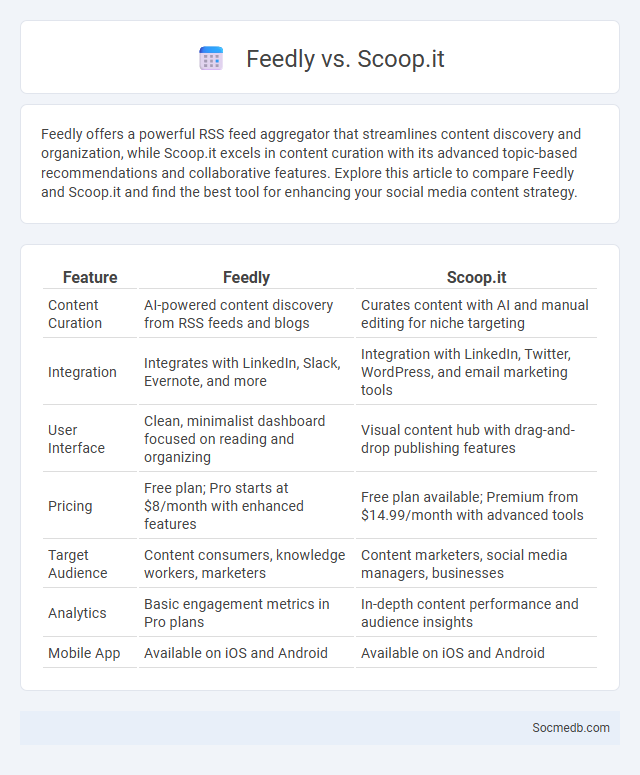
Photo illustration: Feedly vs Scoop.it
Feedly offers a powerful RSS feed aggregator that streamlines content discovery and organization, while Scoop.it excels in content curation with its advanced topic-based recommendations and collaborative features. Explore this article to compare Feedly and Scoop.it and find the best tool for enhancing your social media content strategy.
Table of Comparison
| Feature | Feedly | Scoop.it |
|---|---|---|
| Content Curation | AI-powered content discovery from RSS feeds and blogs | Curates content with AI and manual editing for niche targeting |
| Integration | Integrates with LinkedIn, Slack, Evernote, and more | Integration with LinkedIn, Twitter, WordPress, and email marketing tools |
| User Interface | Clean, minimalist dashboard focused on reading and organizing | Visual content hub with drag-and-drop publishing features |
| Pricing | Free plan; Pro starts at $8/month with enhanced features | Free plan available; Premium from $14.99/month with advanced tools |
| Target Audience | Content consumers, knowledge workers, marketers | Content marketers, social media managers, businesses |
| Analytics | Basic engagement metrics in Pro plans | In-depth content performance and audience insights |
| Mobile App | Available on iOS and Android | Available on iOS and Android |
Introduction to Content Curation
Content curation on social media involves selecting, organizing, and sharing relevant information and media to engage your audience effectively. It enhances your online presence by providing valuable, targeted content that resonates with your followers' interests and needs. Mastering content curation boosts engagement rates and establishes your credibility as a trusted source in your industry.
What is Feedly?
Feedly is a powerful content aggregator that organizes updates from your favorite blogs, news sites, and social media channels into a single, easy-to-navigate feed. It uses RSS feeds to deliver real-time content tailored to your interests, helping you stay informed without spending time browsing multiple websites. Your personalized Feedly experience enhances productivity by centralizing information for efficient consumption and sharing.
What is Scoop.it?
Scoop.it is a content curation platform designed to help users discover, curate, and publish relevant content on specific topics. It enables marketers, educators, and professionals to organize information visually through customized online magazines or boards, enhancing content marketing strategies and thought leadership. With advanced content discovery algorithms and social sharing tools, Scoop.it streamlines the process of sourcing and distributing high-quality content to target audiences.
Key Features of Feedly
Feedly offers a powerful content aggregation platform that consolidates news, blogs, and social media updates into one personalized feed, making information consumption efficient and organized. Its AI-powered filtering and keyword monitoring help you discover the most relevant articles tailored to your interests, boosting productivity and staying ahead in your industry. Integration with apps like Evernote, Slack, and Twitter enhances your ability to share, annotate, and collaborate seamlessly across multiple channels.
Key Features of Scoop.it
Scoop.it emphasizes content curation by enabling users to discover, organize, and share relevant articles within specific niches, enhancing audience engagement. Its smart publishing tools automate content distribution across social media platforms while providing analytics to measure performance and optimize strategy. The platform also supports collaboration through team workspaces, fostering efficient content management and consistent brand messaging.
Feedly vs Scoop.it: Content Discovery
Feedly offers a streamlined content discovery experience by aggregating articles from your selected RSS feeds, making it easy to stay updated on topics relevant to your interests. Scoop.it enhances content curation by enabling you to discover, organize, and publish content on themed boards, fostering engagement with your audience. Choosing the right tool depends on whether you prioritize personalized news aggregation with Feedly or community-driven content curation with Scoop.it for your social media strategy.
Feedly vs Scoop.it: User Experience
Feedly offers an intuitive, minimalist interface designed for quick content consumption and seamless integration with various apps, enhancing productivity for users tracking multiple sources. Scoop.it provides a more curated, topic-centric user experience, allowing users to discover, organize, and share content with robust customization and collaboration tools tailored for content marketers and professionals. Both platforms prioritize efficient content aggregation but differ in their approach to user engagement and content presentation, with Feedly leaning towards speed and simplicity, while Scoop.it emphasizes curation depth and community interaction.
Content Curation Strategies with Feedly and Scoop.it
Content curation strategies with Feedly and Scoop.it enhance social media engagement by streamlining the discovery of relevant, high-quality content from diverse sources. Feedly's AI-driven RSS feeds and topic filters enable efficient aggregation, while Scoop.it offers intuitive content organization and publishing features tailored for audience targeting. Leveraging both platforms boosts content variety, authority, and consistent posting schedules critical for sustained social media growth.
Pros and Cons: Feedly vs Scoop.it
Feedly offers efficient content aggregation with customizable feeds and seamless integration with apps, promoting streamlined information consumption. Scoop.it excels in content curation with advanced topic identification and social sharing tools, enhancing content discovery and engagement for marketers. Feedly's limitations include fewer collaborative features, while Scoop.it may present a steeper learning curve and higher costs for premium options.
Choosing the Best Content Curation Tool
Choosing the best content curation tool involves evaluating features such as ease of use, integration capabilities, and automation options to efficiently manage social media content. Tools like Feedly, Scoop.it, and Pocket offer robust filtering, scheduling, and sharing functionalities that streamline content discovery and distribution. Prioritizing analytics and collaboration features ensures the selected tool supports data-driven strategies and team workflows for optimal social media engagement.
 socmedb.com
socmedb.com